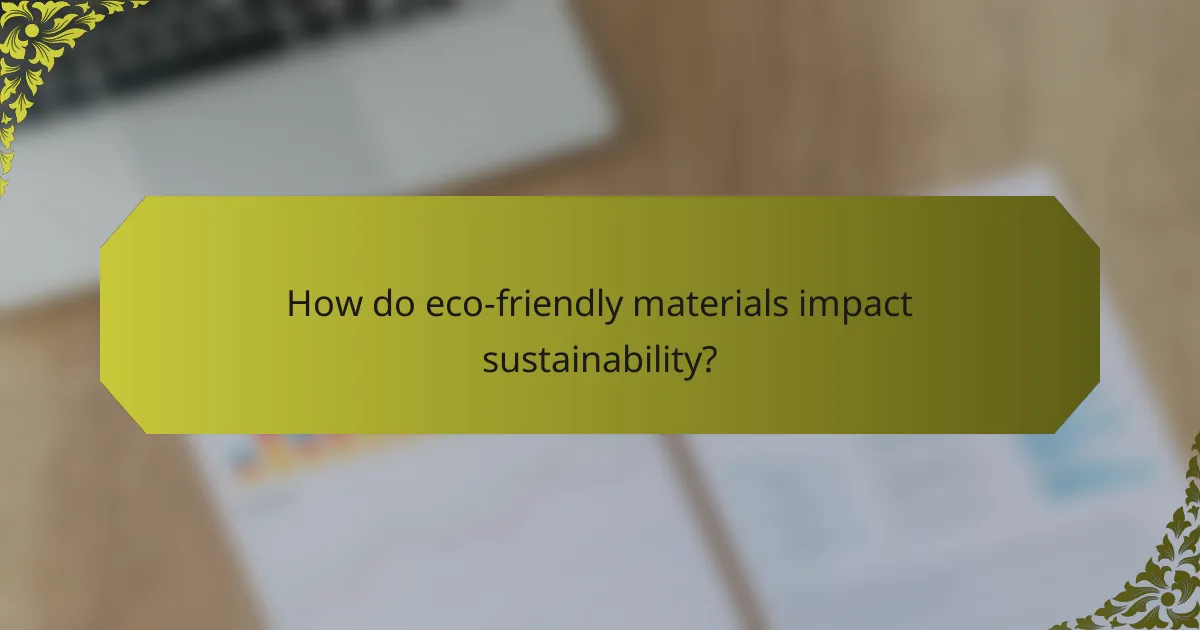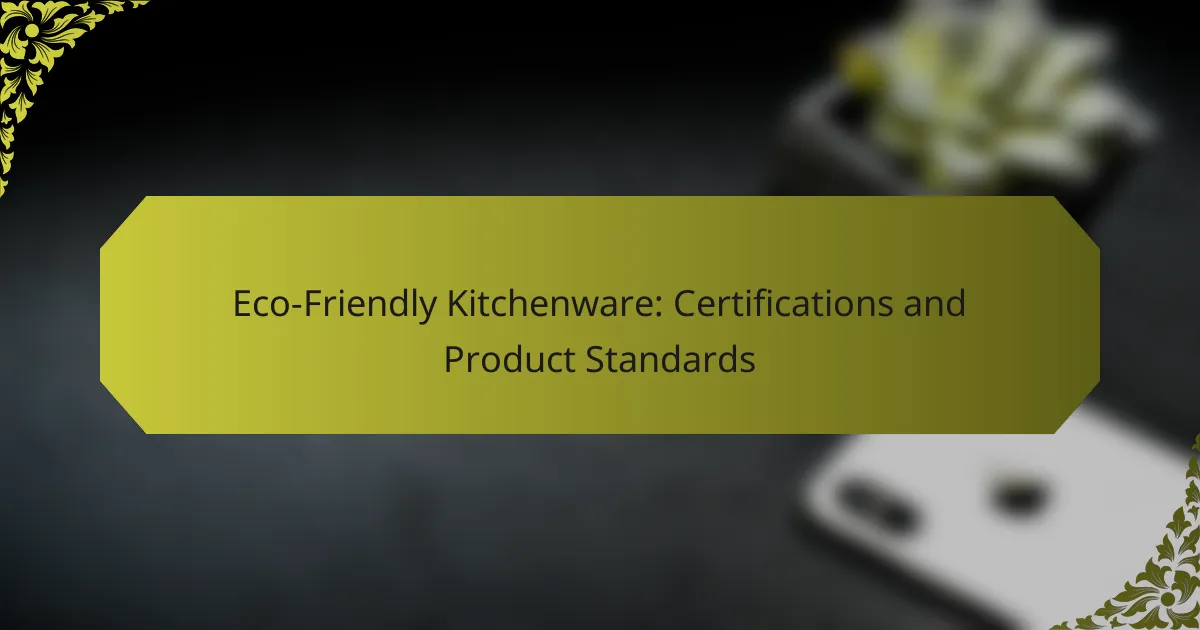Choosing eco-friendly kitchenware is a vital step towards sustainable living, as it involves selecting materials that are sustainable, biodegradable, and non-toxic. These options not only help reduce environmental impact but also foster healthier cooking and food storage practices, promoting a cleaner planet and a better quality of life.

What are the best eco-friendly kitchenware options?
The best eco-friendly kitchenware options include materials that are sustainable, biodegradable, and non-toxic. These choices not only reduce environmental impact but also promote healthier cooking and food storage practices.
Bamboo utensils
Bamboo utensils are a popular choice for eco-friendly kitchenware due to bamboo’s rapid growth and renewability. They are lightweight, durable, and naturally resistant to bacteria, making them safe for food preparation.
When selecting bamboo utensils, look for those that are sustainably sourced and free from harmful chemicals. Avoid products that are coated with synthetic finishes, as these can diminish their eco-friendliness.
Glass storage containers
Glass storage containers are an excellent alternative to plastic, as they are reusable, recyclable, and free from harmful chemicals like BPA. They provide a safe way to store food without the risk of leaching substances into your meals.
Choose glass containers with airtight lids to keep food fresh longer. They are also microwave and dishwasher safe, adding convenience to their eco-friendly benefits.
Stainless steel cookware
Stainless steel cookware is durable and long-lasting, making it a sustainable choice for cooking. Unlike non-stick pans, stainless steel does not release harmful chemicals when heated, ensuring safer food preparation.
When purchasing stainless steel cookware, look for high-quality options that are free from aluminum and other metals that can react with food. Investing in a few versatile pieces can reduce the need for multiple pans and pots.
Compostable plates
Compostable plates are made from natural materials like sugarcane, palm leaves, or wheat straw, offering an eco-friendly alternative to traditional disposable plates. They break down in composting facilities, reducing landfill waste.
When selecting compostable plates, ensure they are certified compostable and check local composting regulations to confirm they can be processed in your area.
Silicone baking mats
Silicone baking mats are reusable alternatives to parchment paper, providing a non-stick surface for baking. They are made from food-grade silicone, which is safe for cooking and can withstand high temperatures.
To maintain their eco-friendliness, avoid using silicone mats with metal or sharp utensils that can cause damage. Regular cleaning with mild soap will help extend their lifespan and usability.

How do eco-friendly materials impact sustainability?
Eco-friendly materials significantly enhance sustainability by reducing environmental harm and promoting resource conservation. These materials are designed to minimize waste, lower emissions, and support a circular economy.
Reduced plastic waste
Using eco-friendly kitchenware helps reduce plastic waste, which is a major contributor to pollution. Materials like bamboo, glass, and stainless steel are alternatives that do not contribute to the growing plastic problem.
For instance, switching to reusable silicone bags instead of single-use plastic bags can cut down waste significantly. Consumers can also look for products with minimal packaging to further decrease plastic use.
Lower carbon footprint
Eco-friendly materials typically have a lower carbon footprint compared to conventional options. For example, products made from recycled materials or sustainably sourced wood require less energy to produce and transport.
Choosing kitchenware from local suppliers can also help reduce transportation emissions. Opting for items made from renewable resources, such as bamboo, can further contribute to a lower overall carbon impact.
Biodegradable properties
Many eco-friendly kitchenware options are biodegradable, meaning they can break down naturally without harming the environment. Materials like cornstarch and certain bioplastics decompose within a few months under the right conditions.
When selecting biodegradable products, check for certifications that ensure they meet composting standards. This can help ensure that the items will return to the earth without leaving harmful residues.

What are the benefits of using sustainable kitchenware?
Using sustainable kitchenware offers numerous advantages, including a healthier cooking environment, a longer product lifespan, and support for ethical brands. These benefits contribute to both personal well-being and a positive impact on the planet.
Healthier cooking environment
Sustainable kitchenware is often made from non-toxic materials that do not leach harmful chemicals into food. For instance, cookware made from stainless steel, glass, or ceramic is free from harmful substances like BPA and PFOA, commonly found in some plastics.
Choosing eco-friendly options helps reduce indoor air pollution and promotes a safer cooking space. Opt for items labeled as food-safe and free from harmful coatings to ensure a healthier kitchen environment.
Longer product lifespan
Eco-friendly kitchenware typically boasts a longer lifespan compared to conventional alternatives. Materials such as bamboo, stainless steel, and cast iron are durable and resistant to wear, meaning they can last for years with proper care.
Investing in high-quality sustainable products may have a higher initial cost, but their longevity often results in lower overall expenses. Regular maintenance, such as seasoning cast iron or avoiding abrasive cleaners, can further extend the life of these kitchen tools.
Support for ethical brands
Purchasing sustainable kitchenware often means supporting brands committed to ethical practices, including fair labor and environmentally friendly production methods. Many eco-conscious companies prioritize transparency and sustainability in their supply chains.
Look for certifications such as Fair Trade or organic labels to identify brands that align with your values. By choosing these products, you contribute to a market that encourages responsible manufacturing and helps reduce environmental impact.

What should I consider when choosing eco-friendly kitchenware?
When selecting eco-friendly kitchenware, prioritize materials that are sustainably sourced, durable, and certified by reputable organizations. These factors ensure that your kitchen tools not only minimize environmental impact but also provide long-lasting value.
Material sourcing
Material sourcing is crucial in determining the eco-friendliness of kitchenware. Look for products made from renewable resources like bamboo, recycled metals, or glass. Avoid plastics derived from fossil fuels, as they contribute significantly to pollution and waste.
Check for certifications that indicate sustainable practices, such as FSC (Forest Stewardship Council) for wood products. Understanding the origin of materials can help you make informed choices that align with your values.
Durability and maintenance
Durability is a key factor in eco-friendly kitchenware, as longer-lasting products reduce the need for replacements and minimize waste. Choose items that can withstand regular use without degrading quickly. For instance, stainless steel and cast iron are known for their longevity.
Maintenance also plays a role in sustainability. Opt for kitchenware that is easy to clean and maintain, reducing the need for harsh chemicals. Items that are dishwasher-safe or require minimal care can save time and resources in the long run.
Brand certifications
Brand certifications provide assurance that products meet specific environmental and ethical standards. Look for labels such as USDA Organic, Fair Trade, or B Corp certification, which indicate a commitment to sustainability and social responsibility.
Research brands to understand their sourcing practices and environmental policies. Supporting certified brands can amplify your impact on promoting sustainable living and encourage more companies to adopt eco-friendly practices.

How does eco-friendly kitchenware compare to traditional options?
Eco-friendly kitchenware often emphasizes sustainable materials and practices, distinguishing it from traditional options. While traditional kitchenware may be cheaper and more widely available, eco-friendly alternatives prioritize environmental benefits and health considerations.
Cost differences
Eco-friendly kitchenware can be more expensive than traditional options due to the higher costs of sustainable materials and ethical production methods. For instance, bamboo utensils or organic cotton dish towels may range from 20% to 50% higher in price compared to their plastic or synthetic counterparts. However, investing in durable, sustainable products can lead to long-term savings as they often outlast cheaper alternatives.
Performance and usability
In terms of performance, eco-friendly kitchenware can vary widely. Many sustainable materials, like stainless steel or glass, offer excellent durability and heat resistance, making them suitable for various cooking tasks. However, some biodegradable options may not withstand high temperatures or heavy use, so it’s essential to assess the specific product’s capabilities before purchasing.
Usability can also differ; for example, bamboo cutting boards are gentle on knives but may require more maintenance than plastic boards. Users should consider their cooking habits and choose products that align with their needs for optimal performance.
Environmental impact
The environmental impact of eco-friendly kitchenware is generally lower than that of traditional options. Sustainable materials, such as bamboo, are renewable and biodegradable, reducing landfill waste. In contrast, many traditional kitchenware items are made from plastics that can take hundreds of years to decompose.
Moreover, eco-friendly products often come from companies that adhere to ethical manufacturing practices, minimizing pollution and resource depletion. Choosing these items supports a more sustainable economy and encourages responsible consumption habits.



